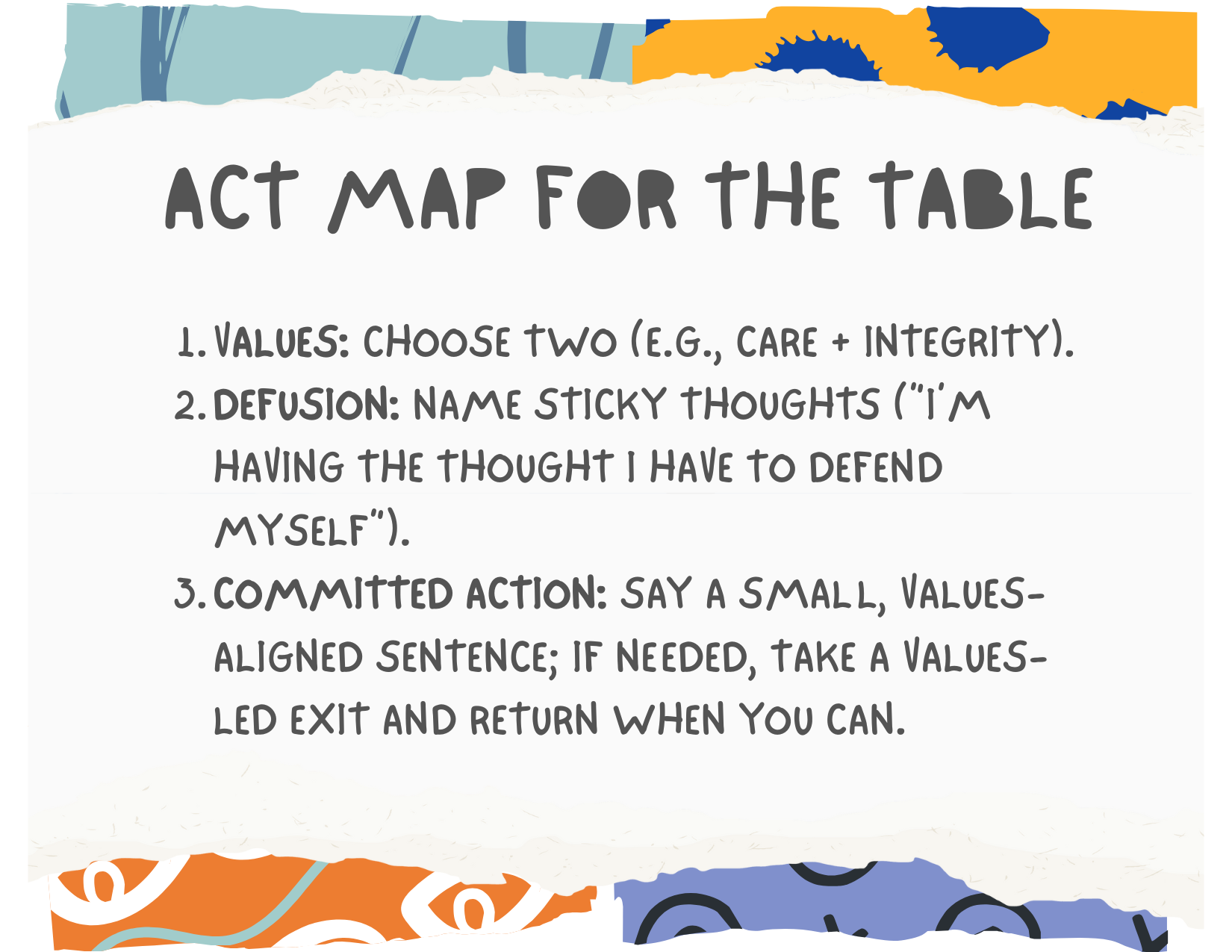Boundaries & Empty Chairs: Getting through the holiday
November 20, 2025
First things first: what boundaries are and aren’t
Think of a boundary not as a line in the sand, but as a way of loving people (including yourself) on purpose. In ACT (Acceptance & Commitment Therapy), boundaries are committed actions that protect what you value—connection, dignity, health—while making room for hard thoughts and feelings (Hayes, Strosahl, & Wilson, 1999/2012). They’re not punishments or ultimatums; they’re agreements with yourself about how you’ll show up, exit, or re-enter with care.
Translation: “If we go deep into calorie talk, I know I’ll either shut down (implode) or get irritable (explode). To love you and me well, I’ll steer us elsewhere—or take a breather and come back.”
“The people most upset by your boundaries are usually the ones who benefited from you having none.”
🗣️ Five ACT-aligned boundary one-liners (politics • food • bodies • prying • escalation)
Politics detour
“I value being together tonight. I’m skipping politics—tell me something good from your week.”
Food policing / calorie talk
“I’m caring for my relationship with food. I’m not discussing calories—let’s talk recipes or favorite flavors.”
Body/appearance comments
“I’m not doing body talk. I’d love to hear a highlight from your year.”
Relentless questions (dating, kids, career)
“I’m keeping that private right now. I’m happy to talk about books/travel/music.”
Escalation cue (voices rising)
“I’m stepping out for 10 minutes to keep this respectful.”
Values Led Exits
“I’m going to help in the kitchen.”
“I’m grabbing some air; back in 10.”
“I’m heading out now. I love you—see you soon.”
Why this works: Assertive, values-consistent language is linked to better relationship functioning and lower distress, especially when paired with acceptance (not suppression) of difficult emotion (Hayes et al., 1999; Neff, 2003).
Grief at the table
Grief isn’t linear, and anniversaries/holidays often re-activate it. Flexible coping—oscillating between loss-oriented moments (tears, memory) and restoration-oriented moments (nostalgic food, laughter)—supports adaptation (Stroebe & Schut, 1999). Many people also find comfort in continuing bonds (carrying a connection forward) rather than “letting go” (Klass, Silverman, & Nickman, 1996).
Ritual options (choose what helps this year)
Place a small candle, photo, or their favorite treat at the table.
One memory round: “A moment I’m grateful for with ___ is…”
Play their song while cooking or driving.
Make/order their signature dish—send leftovers to those who want a piece of remembrance.
Quiet remembrance: a 30-second pause before eating.
If that’s too raw
Keep rituals private (light a candle before you arrive).
Wear a small item that connects you (pin, scarf, recipe card in your pocket).
Text one safe person a memory and leave it there.
What to say to others
“I miss them, and I’m glad we’re together.”
“I’m not up for stories right now, and I love that you are.”
What to skip
“At least…” statements or timelines for grief.
Forcing one script for everyone.
Why this works: Most bereaved people adapt naturally over time without forced reprocessing; compassionate rituals plus flexibility predict resilience (Bonanno, 2004).
🧳 Your plans can be a boundary
A values-consistent “no” is still loving.
“I’m not doing the usual dinner this year—I’m taking a long awaited trip to Rome.”
“I’ll skip the big gathering and stop by for dessert only.”
“I can do the video call for 20 minutes, then I’m off.”
You don’t owe a defense. Add care if you like: “I know change is hard; I’ll call Friday.”
🧩 Both/And permission
You can miss someone fiercely and enjoy the pie.
You can love your family and leave early.
You can be grateful and overwhelmed.
Both things are true—and both deserve room.
🧷 Untrendy but True
You don’t have to earn your boundary—or your grief.
Choose one sentence and one ritual that help you breathe.
That’s enough for this year.
📚 Resources for the Curious
Books
📘 Devine, M. (2017). It’s OK That You’re Not OK.
📘 Samuel, J. (2017). Grief Works. Scribner.
📘 Parker, P. (2018). The Art of Gathering. Riverhead.
Podcasts / Short listens
🎧 Ten Percent Happier: acceptance & compassion practices for tough days.
🎧 On Being: conversations on meaning and grief.
🎧 Griefcast: stories that normalize grief (both tears and laughter).
🧠 References
Bonanno, G. A. (2004). Loss, trauma, and human resilience: Have we underestimated the human capacity to thrive after extremely aversive events? American Psychologist, 59(1), 20–28.
Hayes, S. C., Strosahl, K. D., & Wilson, K. G. (1999). Acceptance and commitment therapy: An experiential approach to behavior change. Guilford Press.
Hayes, S. C., Strosahl, K. D., & Wilson, K. G. (2012). Acceptance and commitment therapy: The process and practice of mindful change (2nd ed.). Guilford Press.
Klass, D., Silverman, P. R., & Nickman, S. (Eds.). (1996). Continuing bonds: New understandings of grief. Taylor & Francis.
Neff, K. D. (2003). Self-compassion: An alternative conceptualization of a healthy attitude toward oneself. Self and Identity, 2(2), 85–101.
Stroebe, M., & Schut, H. (1999). The dual process model of coping with bereavement: Rationale and description. Death Studies, 23(3), 197–224.




